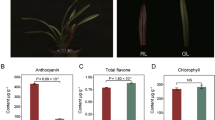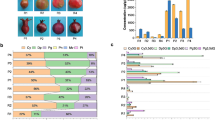Abstract
‘Lingwu Long’ jujube (Ziziphus jujuba cv. Mill) is a fresh fruit variety that is popular in China. Low temperature storage is an important method for retaining fruit quality postharvest. However, jujube fruits are susceptible to surface pitting under low temperature storage. Therefore, we performed transcriptome analysis to investigate the changes in gene expression in surface-pitted jujube fruit (SPF). First, we developed cDNA libraries of SPF and surface-intact fruit (SIF) that had been stored at − 1 ± 0.5 °C. As a result, 21,136,649 and 21,663,126 high-quality clean reads were generated and 47,386 contigs were obtained. Second, we performed sequences annotation by gene description and gene ontology (GO term) analysis, which clustered the genes into three functional groups. A total of 2706 predicted proteins were assigned to specific metabolic pathways by the Kyoto Encyclopedia of Genes and Genomes database. An analysis of differential gene expression between SPF and SIF revealed more than 1210 genes that are differentially expressed in jujube in response to surface-pitting under low temperature storage, which are involved in lipid, carbohydrate, energy, amino acid, terpenoids, and polyketides metabolism, as well as membrane transport, signal transduction, translation, signal transduction, and biosynthesis of other secondary metabolites. We investigated the pattern of phenylalanine ammonia lyase gene expression in SPF by quantitative reverse-transcription PCR analysis. Our results provide new insights into the biology of surface pitting in jujube, which occurs under low temperature storage. Our findings help confirm the low-temperature tolerance pathways that function in postharvest fruit.










Similar content being viewed by others
References
Aghdam MS, Bodbodak S (2014) Postharvest heat treatment for mitigation of chilling injury in fruits and vegetables. Food Bioprocess Technol 7:37–53
Aghdam MS, Asghari M, Farmani B, Mohayeji M, Moradbeygi H (2012) Impact of postharvest brassinosteroids treatment on PAL activity in tomato fruit in response to chilling stress. Sci Hortic 144:116–120
Allen DJ, Ort DR (2001) Impacts of chilling temperatures on photosynthesis in warm-climate plants. Trends Plant Sci 6:36–42
Baginsky S, Hennig L, Zimmermann P, Gruissem W (2010) Gene expression analysis, proteomics, and network discovery. Plant Physiol 152:402–410
Cao S, Yang Z, Zheng Y (2013) Sugar metabolism in relation to chilling tolerance of loquat fruit. Food Chem 136:139–143
Chen ZZ, Xue CH, Zhu S, Zhou FF, Ling X, Liu GP, Chen LB (2005) GoPipe: streamlined gene ontology annotation for batch anonymous sequences with statistics. Prog Biochem Biophys 32:187–190
Fung R, Wang CY, Smith DL, Gross KC, Tian MS (2004) MeSA and MeJA increase steady-state transcript levels of alternative oxidase and resistance against chilling injury in sweet peppers (Capsicum annuum L.). Plant Sci 166:711–719
Huang J, Zhang C, Zhao X, Fei Z, Wan K, Zhang Z, Pang X, Yin X, Bai Y, Sun X, Gao L, Li R, Zhang J, Li X (2016) The jujube genome provides insights into genome evolution and the domestication of sweetness/acidity taste in fruit trees. PLoS Genet 12(12):e1006433. https://doi.org/10.1371/journal.pgen.1006433
Hwang EW, Kim KA, Park SC, Jeong MJ, Byun MO, Kwon HB (2005) Expression profiles of hot pepper (Capsicum annuum) genes under cold stress conditions. J Biosci 30:657–667
Kanehisa M, Goto S, Furumichi M, Tanabe M, Hirakawa M (2010) KEGG for representation and analysis of molecular networks involving diseases and drugs. Nucleic Acids Res 381:D355–D360
Li L, Ban Z, Li X, Xue T (2014a) Effect of 1-methylcyclopropene and calcium chloride treatments on quality maintenance of ‘Lingwu Long’ jujube fruit. J Food Sci Technol 51:700–707
Li P, Zheng X, Liu Y, Zhu Y (2014b) Pre-storage application of oxalic acid alleviates chilling injury in mango fruit by modulating proline metabolism and energy status under chilling stress. Food Chem 142:72–78
Li Y, Xu C, Lin X, Cui B, Wu R, Pang X (2014c) De novo assembly and characterization of the fruit transcriptome of Chinese jujube (Ziziphus jujuba Mill.) using 454 pyrosequencing and the development of novel tri-nucleotide SSR markers. PLoS ONE 9:e106438
Liu H, Jiang-Kuo LI, Nong SZ, Zhang P, Kou WL (2012) Effect of different temperature on chilling injury of ‘Dongzao’ Jujube. Sci Technol Food Ind 33:344–348
Liu M, Zhao J, Cai Q, Liu G, Wang J, Zhao Z, Liu P, Dai L, Yan G, Wang W, Li X, Chen Y, Sun Y, Liu Z, Lin M, Xiao J, Chen Y, Li X, Wu B, Ma Y, Jian J, Yang W, Yuan Z, Sun X, Wei Y, Yu L, Zhang C, Liao S, He R, Guang X, Wang Z, Zhang Y, Luo L (2014) The complex jujube genome provides insights into fruit tree biology. Nat Commun 5:5315
Livak KJ, Schmittgen TD (2001) Analysis of relative gene expression data using real-time quantitative PCR and the 2−ΔΔCT method. Methods 25:402–408
Mirdehghan SH, Rahemi M, Martinez-Romero D, Guillen F, Valverde JM, Zapata PJ, Serrano M, Valero D (2007) Reduction of pomegranate chilling injury during storage after heat treatment: role of polyamines. Postharvest Biol Technol 44:19–25
Mortazavi A, Williams BA, McCue K, Schaeffer L, Wold B (2008) Mapping and quantifying mammalian transcriptomes by RNA-Seq. Nat Methods 5:621–628
Ng P, Wei CL, Sung WK, Chiu KP, Lipovich L, Ang CC, Gupta S, Shahab A, Ridwan A, Wong CH, Liu ET, Ruan Y (2005) Gene identification signature (GIS) analysis for transcriptome characterization and genome annotation. Nat Methods 2:105–111
Nordby HE, Mcdonald RE (1991) Relationship of epicuticular wax composition of grapefruit to chilling injury. J Agric Food Chem 39:957–962
Rice P, Longden I, Bleasby A (2000) EMBOSS: the European molecular biology open software suite. Trends Genet 16:276–277
Ruelland E, Vaultier M, Zachowski A, Hurry V (2009) Cold signalling and cold acclimation in plants. In: Kader JC, Delseny M (eds) Advances in botanical research. Academic Press, Cambridge, pp 35–150
Rui H, Cao S, Shang H, Jin P, Wang K, Zheng Y (2010) Effects of heat treatment on internal browning and membrane fatty acid in loquat fruit in response to chilling stress. J Sci Food Agric 90:1557–1561
Sanchez-Bel P, Egea I, Teresa Sanchez-Ballesta M, Martinez-Madrid C, Fernandez-Garcia N, Romojaro F, Olmos E, Estrella E, Bolarin MC, Borja Flores F (2012) Understanding the mechanisms of chilling injury in bell pepper fruits using the proteomic approach. J Proteomics 75:5463–5478
Sevillano L, Sanchez-Ballesta MT, Romojaro F, Flores FB (2009) Physiological, hormonal and molecular mechanisms regulating chilling injury in horticultural species. Postharvest technologies applied to reduce its impact. J Sci Food Agric 89:555–573
Singh Z (2015) Lost fresh horticultural produce and maintenance of quality in supply chain: tropical and sub-tropical fruit. In: Acedo AL, Kanlayanarat S (eds) Acta horticulturae, vol 1. International Society for Horticultural Science, Leuven, pp 29–39
Wan CY, Wilkins TA (1994) A modified hot borate method significantly enhances the yield of high-quality RNA from cotton (Gossypium hirsutum L.). Anal Biochem 223:7–12
Wang C (1982) Physiological and biochemical responses of plants to chilling stress. HortScience 17:173–186
Wang Y, Chen J, Jiang Y, Lu W (2007) Cloning and expression analysis of phenylalanine ammonia-lyase in relation to chilling tolerance in harvested banana fruit. Postharvest Biol Technol 44:34–41
Wang L, Feng Z, Wang X, Wang X, Zhang X (2010) DEGseq: an R package for identifying differentially expressed genes from RNA-seq data. Bioinformatics 26:136–138
Watkins CB, Gapper NE, Nock JF, Giovannoni JJ, Rudell DA, Leisso R, Lee J, Buchanan D, Mattheis J, Hertog M, Nicolai BM, Johnston J, Schaffer R (2015) Interactions between 1-MCP and controlled atmospheres on quality and storage disorders of fruits and vegetables. In: Amodio ML, Colelli G (eds) Acta horticulturae, vol 1. International Society for Horticultural Science, Leuven, pp 45–58
Xiao J, Zhao J, Liu M, Liu P, Dai L, Zhao Z (2015) Genome-wide characterization of simple sequence repeat (SSR) Loci in Chinese jujube and jujube SSR primer transferability. PLoS ONE 10:e0127812
Zhang C, Tian S (2009) Crucial contribution of membrane lipids’ unsaturation to acquisition of chilling-tolerance in peach fruit stored at 0 °C. Food Chem 115:405–411
Zhang C, Tian S (2010) Peach fruit acquired tolerance to low temperature stress by accumulation of linolenic acid and N-acylphosphatidylethanolamine in plasma membrane. Food Chem 120:864–872
Zhang C, Ding Z, Xu X, Wang Q, Qin G, Tian S (2010) Crucial roles of membrane stability and its related proteins in the tolerance of peach fruit to chilling injury. Amino Acids 39:181–194
Zhang Z, Tian S, Zhu Z, Xu Y, Qin G (2012) Effects of 1-methylcyclopropene(1-MCP) on ripening and resistance of jujube (Zizyphus jujuba cv. Huping) fruit against postharvest disease. LWT Food Sci Technol 45:13–19
Acknowledgements
This work was supported by the Key Projects in the National Science and Technology Pillar Program during the Twelve Five-year Plan Period of China (2015BAD16B02) and Natural Science Foundation of Tianjin (17JCZDJC34300).
Author information
Authors and Affiliations
Corresponding author
Electronic supplementary material
Below is the link to the electronic supplementary material.
Rights and permissions
About this article
Cite this article
Liu, X., Wang, T., Chen, L. et al. Transcriptomic and gene expression changes in response to postharvest surface pitting in ‘Lingwu Long’ jujube fruit. Hortic. Environ. Biotechnol. 59, 59–70 (2018). https://doi.org/10.1007/s13580-018-0007-1
Received:
Revised:
Accepted:
Published:
Issue Date:
DOI: https://doi.org/10.1007/s13580-018-0007-1




